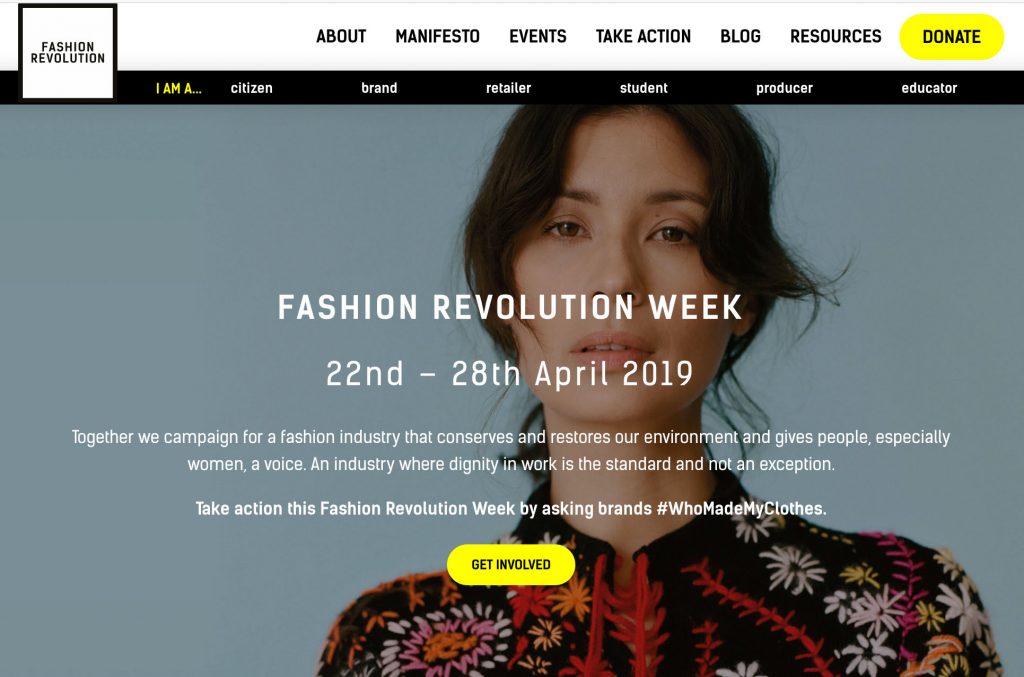
April 22nd-28th 2019 has been Fashion Revolution Week so on my insta @style.sense I’ve been touching on more sustainable approaches to your wardrobes, Sydney!!! However, this subject, which is VERY close to my heart, also needs a broader platform for further discussion, so here goes….
The Fashion Revolution believes ‘in a fashion industry that values people, the environment, creativity and profit in equal measure.’
They are people from all around the world who make the fashion industry work, the people who wear clothes and the people who make them and I include myself in that group. Having designed women’s clothes for international brands for 15 years means that I’ve helped shape the global fashion industry.
Personal Stylist In Sydney
Today as a personal stylist, I work closely with clients on how to dress well, coaching them on better buying habits, wardrobe makeovers and the clothes styles that represent value. This means I have a duty to them, but also to the environment.
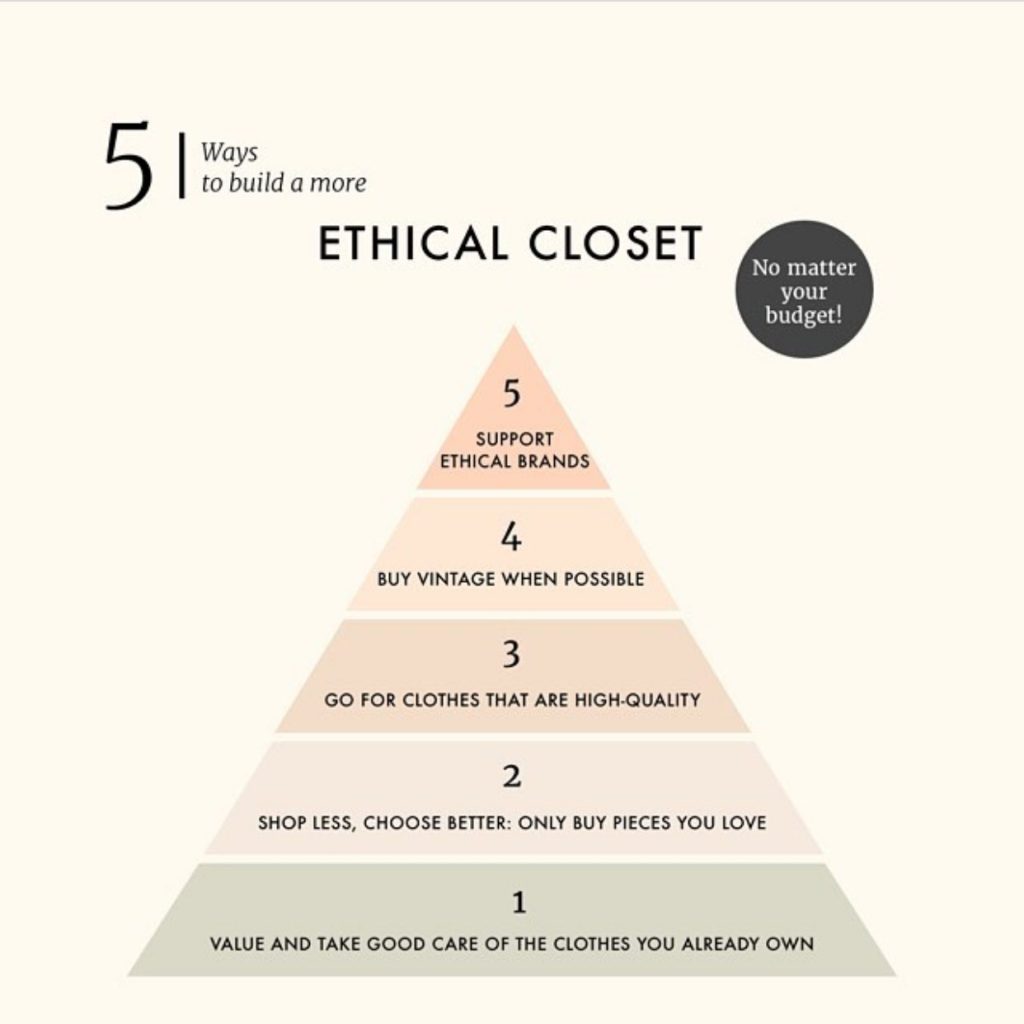
Sustainable Fashion Triangle
Many moons ago I came across this simple triangle which outlined 5 ways to create a more ethical wardrobe by @anuschkarees the fantastic author of The Curated Closet which is the perfect way to illustrate my points.
So the obvious way to become more environmentally sustainable is to start shopping from sustainable brands as outlined at the top of this triangle, point 5, but there’s loads of other ways to start your own little fashion revolution, have you considered these fashion tips…?

1. Value and take care of the clothes you already own
This area offers the most diverse opportunities to prolong the life of your clothes.
/. Repairing = Makeover

It’s all too easy to consider throwing things away when they start to become a bit worn out, but a lot of times we can repair and re-wear!
Repairing means you give a style make over to your clothes and accessories, extending their life and avoids buying a new version, which in my personal shopper experience, can often mean 2 or 3 purchases until you eventually find the ideal replacement!!
It also means the memories the piece has collected remain as well as keeping handcraft skills alive which is another vital component of the fashion revolution. I know my local cobbler is a frickin magician and let’s face it, shoes are THE most difficult – and irritating – item to replace, I’m still trying to update a Wittner sandal from 2006!!!????!!!
I also get a real kick when my daughter makes a whole in her pants and doesn’t want to throw them away, but instead asks “mummy, can you sew them up?”
#raisingthefuture
//. Changing Body Types
As we grow older, our body types change which means we can’t always continue to wear our clothes as we would like, so I offer fashion tips on how to make your clothes fit you through making small adjustments, some of which don’t even need sewing! This can help you extend the life cycle of your clothes, particularly helpful for those who’s weight fluctuates as it eliminates the need for 2 different sized wardrobes!!
Here’s a couple of helpful mini-vid’s and check out my instastories for more help on how to flatter different female body types.
///. Be Your Own Fashion Stylist
Rather than habitually buying a new outfit for an occasion, shop in your own wardrobe and create a new outfit from your current belongings. Trust me, there’s at least 50 outfits you’ve never worn before (based on my personal stylist experience) in the average wardrobe, so experiment! If this is what you struggle with then book in for a WARDROBE MAKEOVER today!
////. Style Makeover
Customising or altering clothes is an approach I also champion! Small changes can reinvigorate even your most tired of clothes, see how I give my own second hand skirt a style makeover below or on my instagram @style.sense and instastories
Make more, from less!
/////. Swap, Rent, Sell or Borrow
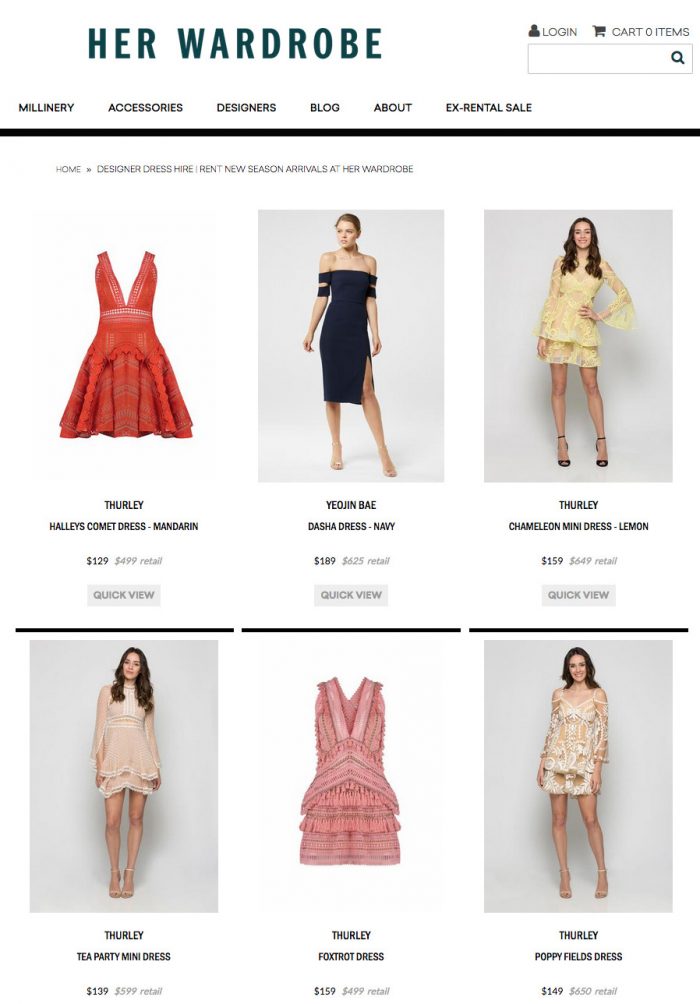
Another way to be your own fashion stylist is to borrow or swap an item with a friend, you know… that friend who’s been eyeing up that fancy frock of yours?? Lend it to her and borrow something in return? If you’re different sizes then try accessories? Voilà, instant newness at no cost to you or the environment!
During my personal styling sessions, I always advise my clients to sell unwanted pieces that are in good condition and recycle the money. Alternatively, your clothes can create revenue through renting them out? I wrote a blog about 18 months ago suggesting people rent outfits for upcoming occasions which details companies to use, read it here
//////. Decrease Dry Cleaning
I posted a mini-vid on my instastories about dry cleaning and how bad it is for our clothing AND our pocket! It also touches on the best hangers to use, see below:
///////. Stains Ain’t Stylish
The quicker you treat a stain, the quicker it will disappear.
In short, if you look after your clothes, your clothes will look after you!

2. Shop Less, Choose Better, Only Buy Pieces You Love
Changing buying habits makes the biggest environmental impact as we try to slow down the fashion industry.
We all have the power to make a positive change through reducing how much we consume but humans are creatures of habit, so frivolous consumption is a bad habit we need to kick!
Be Your Own Personal Shopper
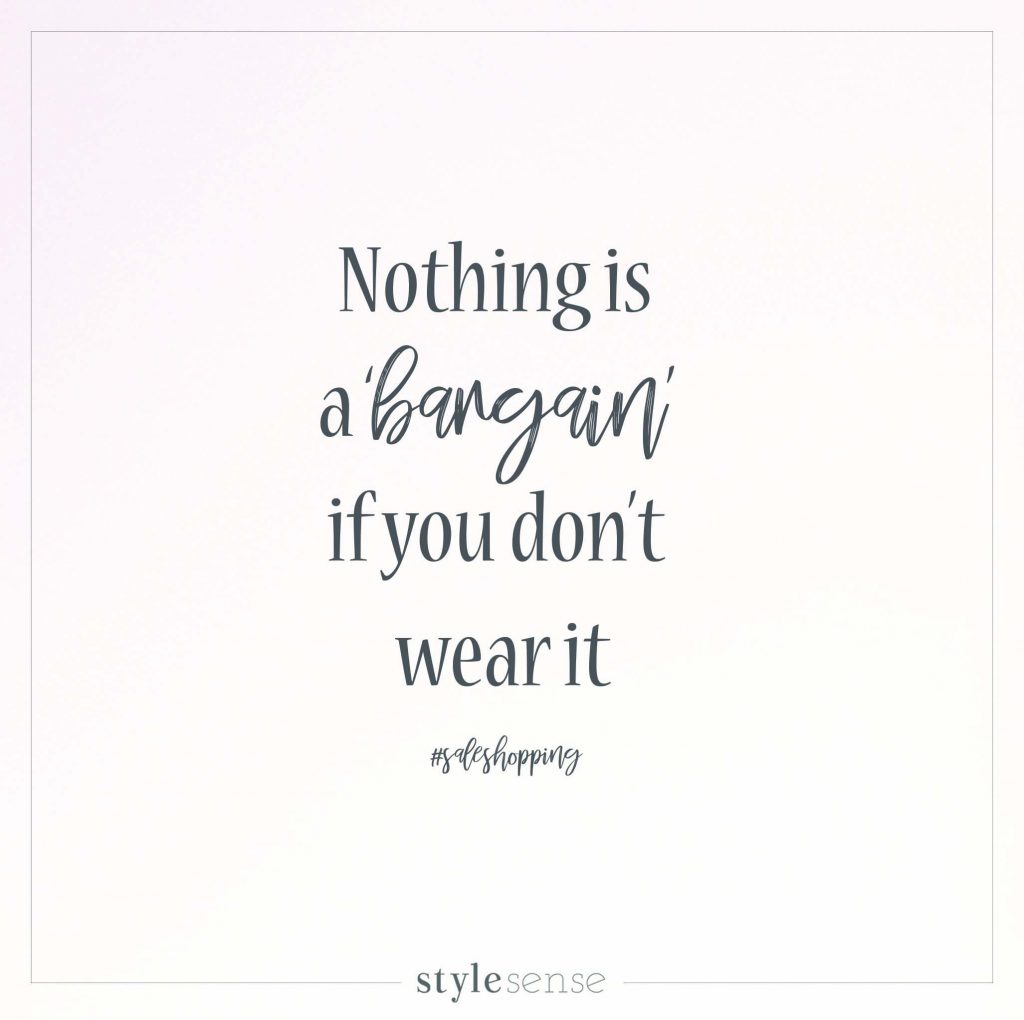
So when you’re at the purchasing decision stage, please ask yourself if you’re buying that $20 skirt because it’s a ‘bargain’ when you know you won’t really wear it, or do you really need that top in 3 colors or would just 2 colours satisfy you better? Yes it’s a lovely top, but in my personal shopper experience, the third colour will be the one that still has tags on when I come round. ;-0
I have many clients who buy, buy buy, hoping that one of the items will be the one that brings them joy, where as if they evaluated their wardrobe first understood their needs and created a list, shopping would be much more satisfying. I create a personalised shopping list for each client during my personal styling services so if this would be a game changer for you, call me to book in for a PERSONAL SHOP so we can create yours.
I find it interesting that we wouldn’t pay iTunes for mediocre music to add to our playlist, but yet for some reason we pay to add mediocre things to our wardrobe?

3. Go For Clothes That Are High Quality
As a wardrobe planner I always advise clients to plan their wardrobe beyond one, two, or even three seasons. Honestly identify what you wear on repeat and buy a couple of different versions for various occasions & seasons. Easy!

Approximately half of all my clients say they’re at a point where they want to ‘buy less and choose well’, but not all of them have the finances to buy from designer or the haute-street (high end high street) which is where we think we need to purchase investment pieces from.
Wrong!!
Some of my hardest working clothes over the last 15 years have been purchased from ‘fast fashion’ brands! You just have to know what you’re looking for.
Not All ‘Fast Fashion’ Is Bad Fashion
In my experience, my expensive items can have just as many faults as my cheaper pieces. My Catherine Malendrino coat constantly had buttons falling off, the metal strap of my Jimmy Choo bag broke after 2 months and the lining of my Camilla & Marc jacket split at the seams.
The problem is, you part with so much more money for designer so your expectation is so much higher!
Fashion Designer Tips
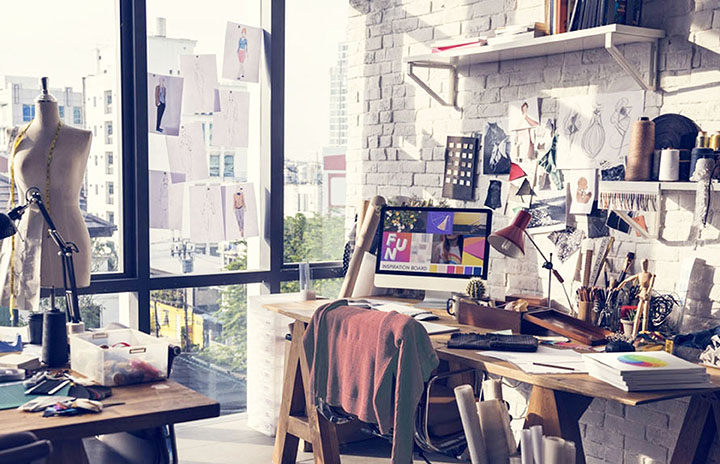
When I designed in the UK, many of my overseas factories I used at a ‘fast fashion’ level were highly skilled and my fabric quality was surprisingly good, purely due to economies of scale – fashion brands were buying so many pieces, sometimes 50,000 items, that they could afford a beautiful wool melton that actually contained…lots of wool!
Compare that to Australia and a healthy order for a lot of brands is around 5-10,000, hence why the fabric quality – which is the main cost of any garment – had to contain less wool. So for me there’s a difference between UK ‘fast fashion’ brands and countries with smaller populations.
Fast Fashion
The main point for me is that if you purchase fast fashion, treat it with care still. Unfortunately the expectation is that you will discard of it after a year which is outdated and often unnecessary. If you value the item and take good care of it as if it was an investment purchase, it might last longer?
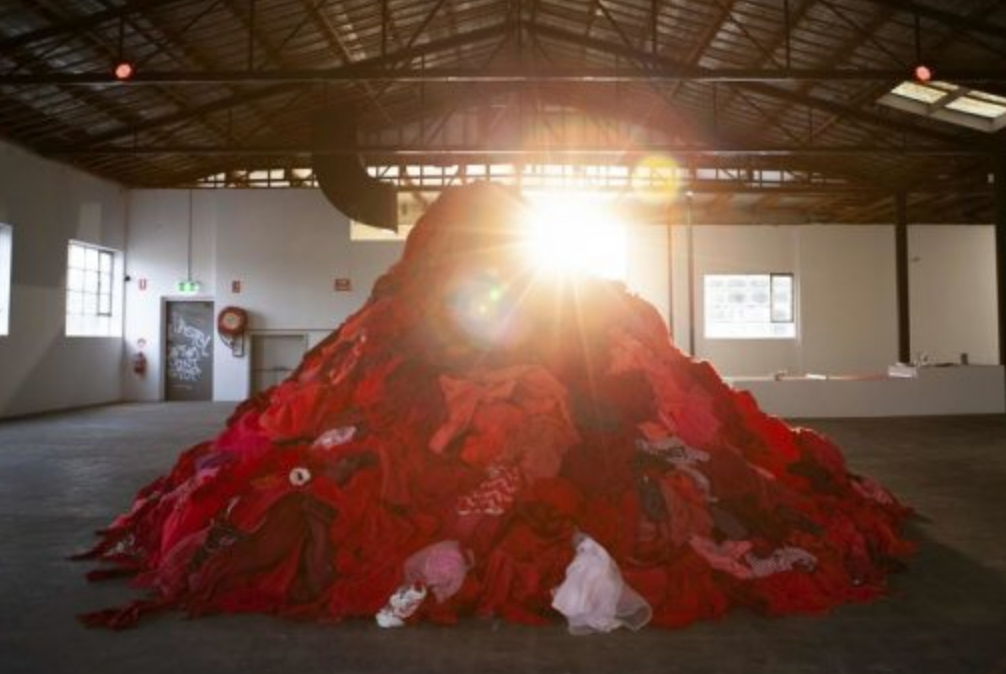
If you saw your wardrobe through the eyes of a child who has no concept of cost, then you would value most those pieces that simply made you happy!
We also need to be aware when buying fast fashion that it’s from sources that pay their factory workers a fair wage in a safe environment, so do your research. This is the other vital part of The Fashion Revolution.
Considered Consumption
So I’m not saying that buying cheaper clothes is good or bad, price is actually irrelevant as long as you wear them and enjoy them through their full life cycle and if a button does fall off, then recognize that sometimes that happens, regardless of the where or how it’s been made.
What I AM saying is that any frivolous consumption of clothes bought from any market level is something we need to reduce
So I agree that we should ‘Go For Clothes That Are High Quality’ but that we need to add ‘the highest quality you can afford’ and understand that just because it’s less expensive, does not mean it’s any less valuable to our wardrobe. Some of my clients swear by Target jeans which have been washed and worn weekly for half a decade and they’re still fitting well!! They are valuable to that client.
I have to add a disclaimer here that generally designer pieces ARE made better from higher quality materials with superior garment construction, the debate often happens more between high-street and haute-street.
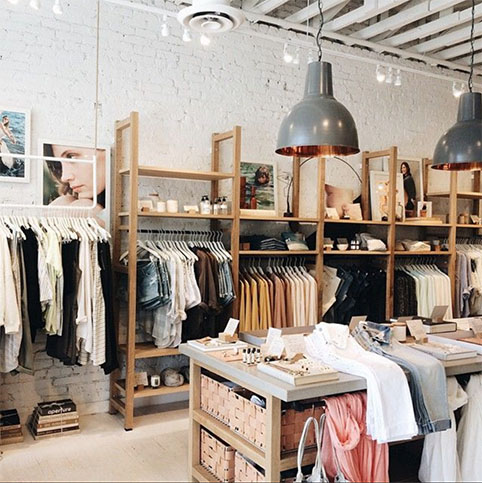
What To look For When Buying Investment Pieces (from any market level):
- Fabric – does it crush or pill easily? Is it an open weave, ie. will it catch and pull easily making it look tatty after just a few wears? It needs to be robust to withstand daily/weekly life
- Seams – pull the garment at the seams to check firm construction, same with buttons, zips, metal details etc
- Fashion Style – is it a trend led piece that will date or will you love the design details way beyond next season?
- Does It Fit Your Body Type – if it’s a snug fit then chances are it won’t be flexible enough to see you through the next decade
- Does It Fit Your Lifestyle – it’s all too easy to wish we had chauffeur driven lifestyle but be brutally honest about YOUR lifestyle needs and plan your wardrobe accordingly
- Laundering – if it’s a piece you plan to wear weekly, can you wash it in the machine?
- Colour – does the colour flatter your features or is it a classic shade that will still look modern in years to come? Is the colour versatile enough to work with the rest of your wardrobe?
- Versatility – talking of versatile, can it be worn with different shoes, jackets AND cardigans, skirts AND pants etc? Experiment whilst you’re IN the shop
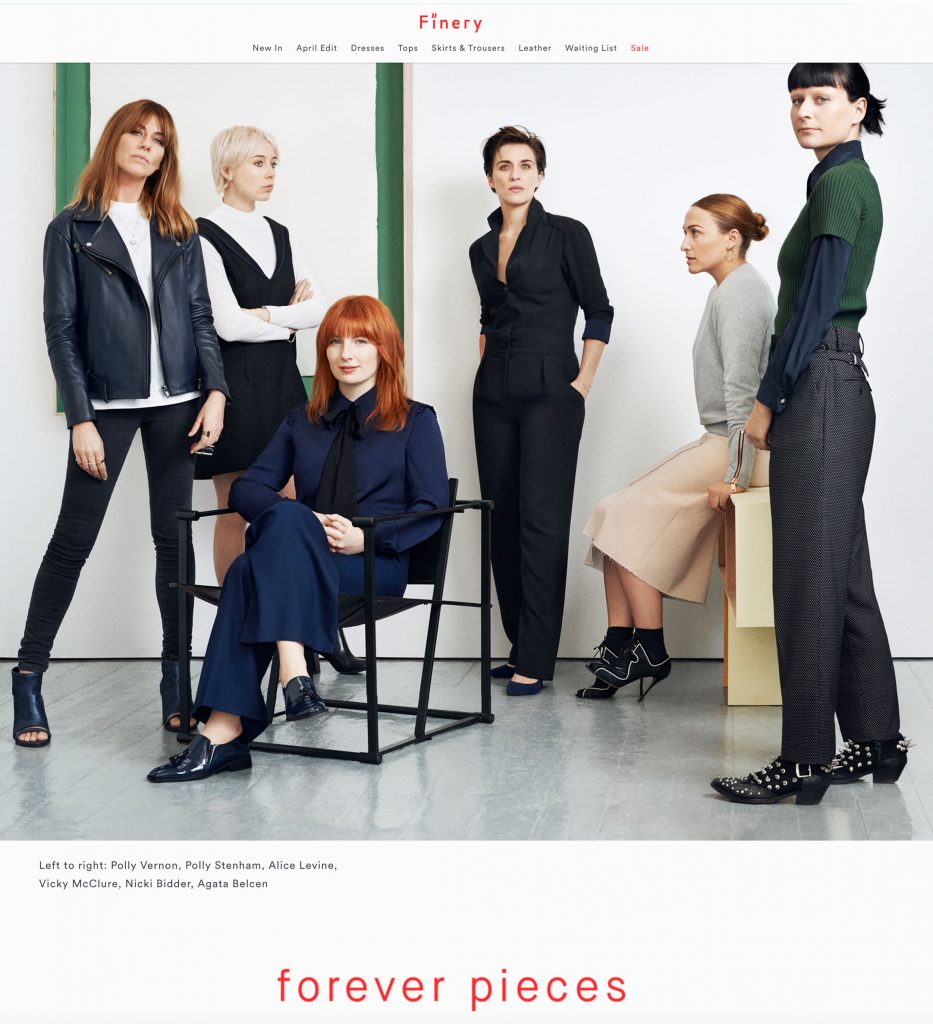
Forever Pieces
For a few years now, certain brands have been marketing certain pieces from their collection as ‘forever pieces’ and I LOVE this. Not only does it make you think differently about the item but we can expect the design to be superior as it’s more considered, made from a fabric that is easy care, easy wear.
Knowing Your Fabrics
Textile advances made from cellulose found in wood pulp harvested from tree farms, create more environmentally sustainable fabrics such as rayon, modal and lyocell. This results in super soft, breathable fabrics that need less dye than cotton…. and they’re increasingly taking over my wardrobe!! If you haven’t seen them, check out garment care labels when you’re next at the shops

4. Buy Vintage When Possible
And I think we need to add ‘secondhand’ here too as not everything pre-owned will technically be ‘vintage’.
Purchasing from opshops not only gives a new lease of life to a piece that might otherwise end up in landfill, but simultaneously giving to charity. Win-win guilt free kinda shopping.
My stylist tips – head for the leather, denim and belts !!
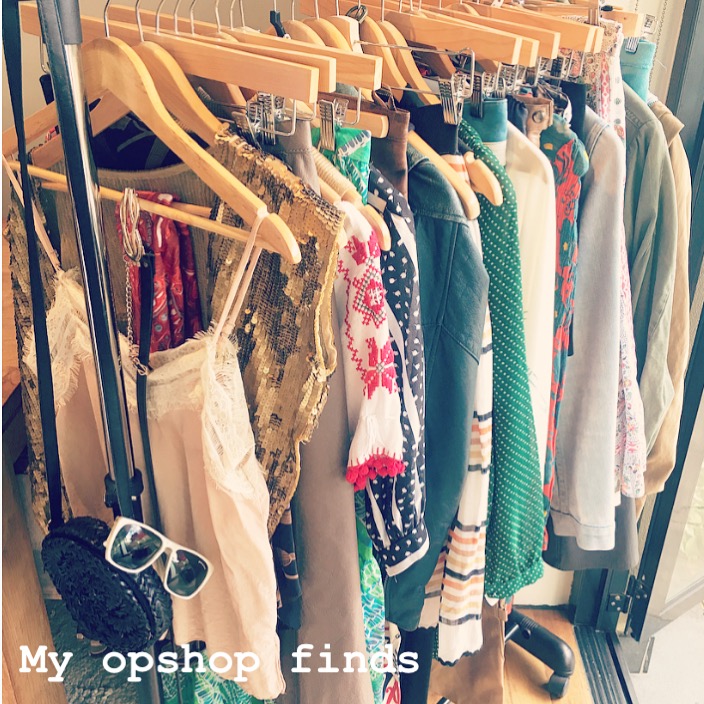
Stylist Finds
Above are my secondhand items which make up about 1/4 of my entire wardrobe. Granted I have been collecting these since I was a teenager which was when I started my opshop ‘addiction’.
The fact that I could pick up a completely unique new frock, or leather skirt that would generally retail for 8 times the price of my local charity shop gave me such a thrill…a thrill that continues to this day! It gives me a real kick when I receive compliments on an item I thrifted for $10!!
What’s the saying, “one man’s trash is another man’s treasure?”
Op-shops are perfect for people on a tighter budget or who want something unique.
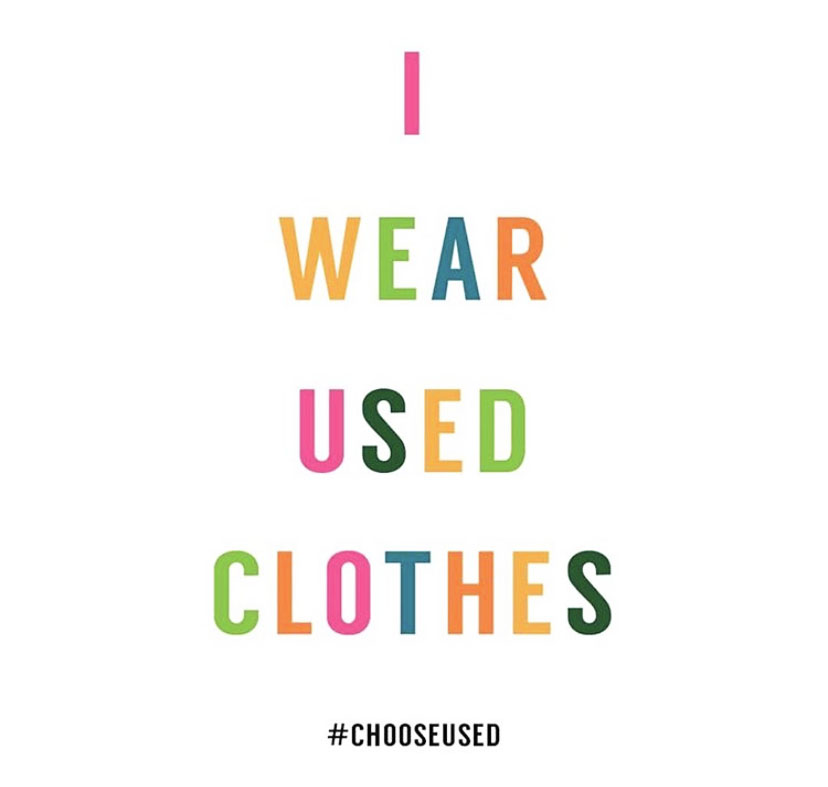
We should also mention giving your unwanted items to charity, a textile bin – found in H&M and Zara – or give to a friend who you think would enjoy wearing it?!
This stat below from Timeout for Fast Fashion Greenpeace shocked me by how easily we could reduce emissions, just by doubling the life cycle of a garment from one year to two!
Maybe we should start to think of our clothes as having 2 lives, how are you going to reincarnate yours? Remember, it could even be a patchwork quilt or cushion cover?
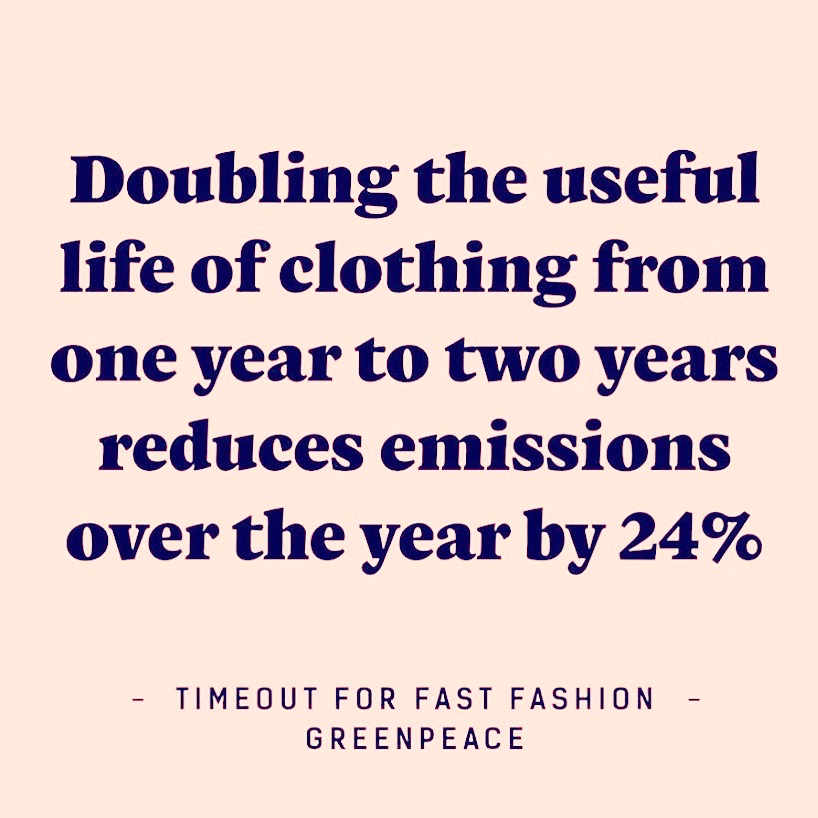
Who Made My Clothes?
Another aspect of Fashion Revolution Week is asking ‘who made my clothes’.
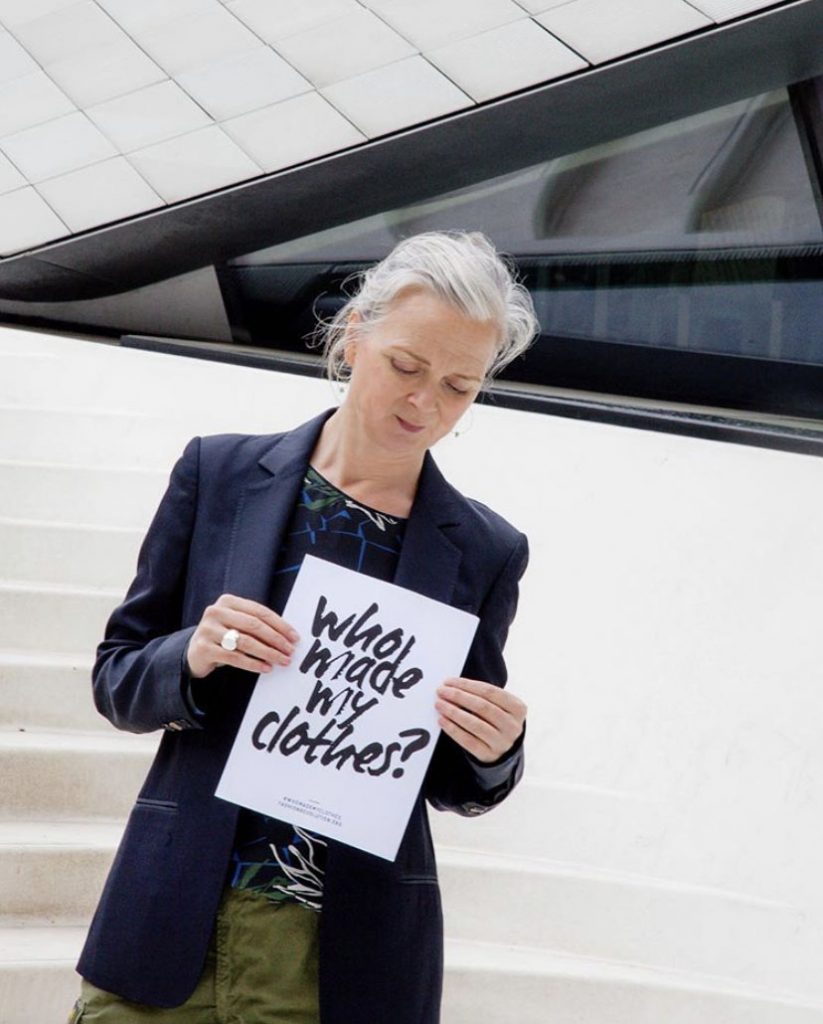
@thatsnotmyage 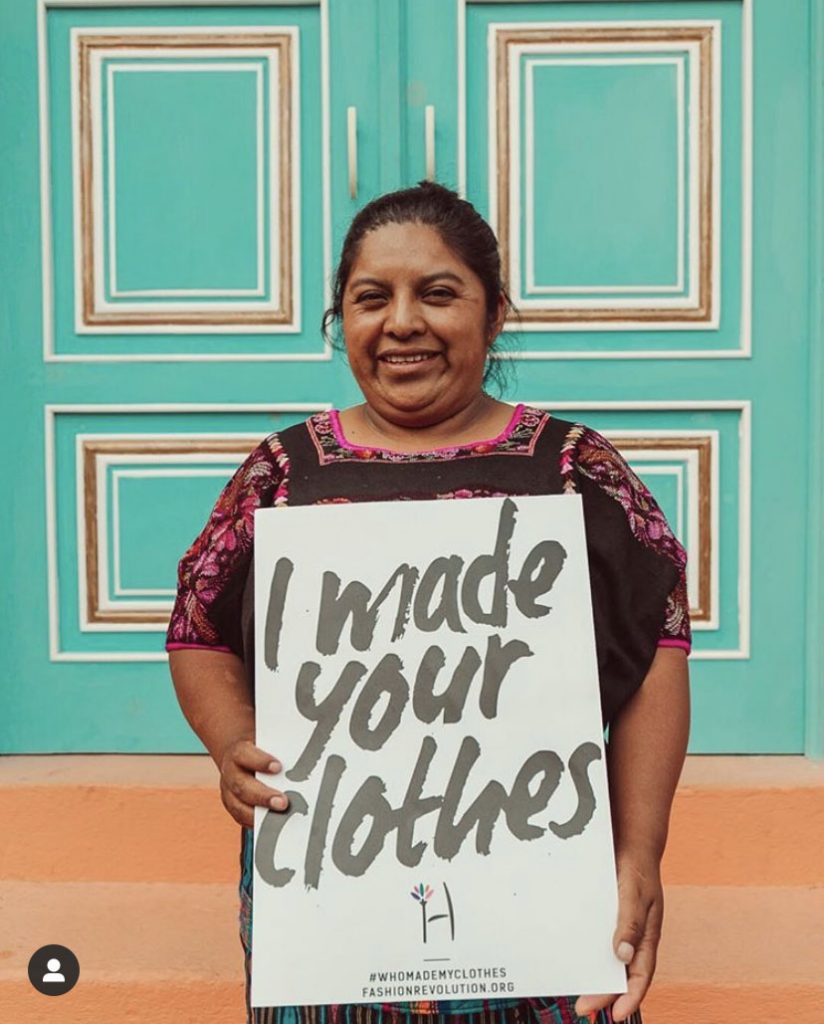
@hiptipco
Life Changing Fashion
When I lived in the UK and designed clothes for Marks & Spencer, we were such a hugely successful international brand that we used to generate enough sewing for factories to be expanded which created a need for fresh running water and a newly built school and hospital. It was incredible, to think that my designs were supporting small villages!?!
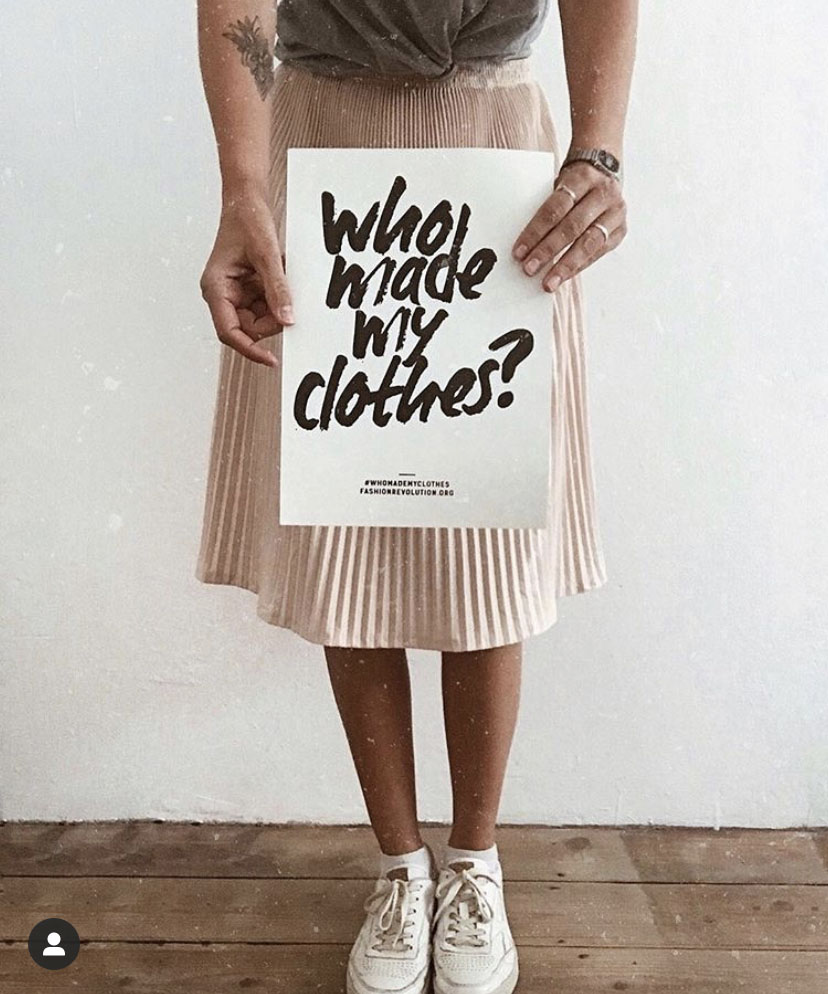
@kissenundkarma 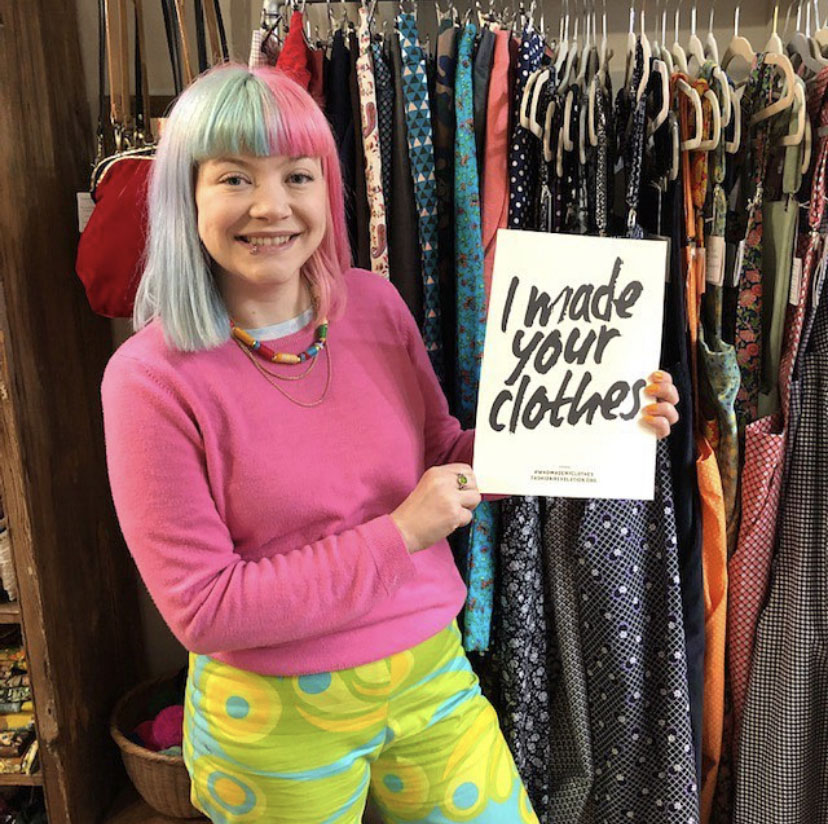
@godivaedinburgh
This was the opposite to some of the fast fashion networks I had previously worked in.
This was life changing fashion.
Accountability
So in summary, we need to be accountable for how many textiles we consume (regardless of how much cash we pay for them) in exactly the same way we’re accountable for the amount of food we consume. We only need a certain amount and it’s nice to indulge occasionally but fundamentally we don’t need cupboards full of clothes we don’t enjoy.
That is NOT a functional wardrobe.
If you would like a wardrobe makeover or need a personal shop with a sustainable approach then contact me to book in and lets each make a mini fashion revolution starting NOW!!
